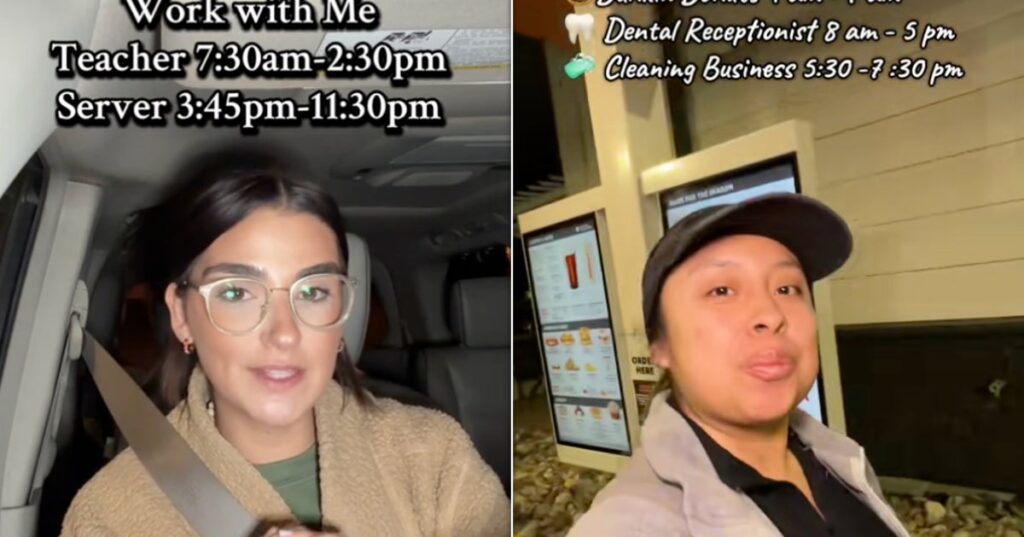“I’m a teacher by day, server by night, mom of seven 24/7” is how Ashley begins many of her TikTok videos.
Ashley, a Pennsylvania-based high school teacher who asked not to share her full name for privacy, has been creating popular TikToks since December about how she works as a server some evenings after her full shift as a teacher.
Ashley follows the luxury lifestyles other mom TikTokers post about, but “that’s also not most people’s reality,” she told HuffPost. Ashley started posting TikToks about her shifts because she wanted to show what it’s really like to be a mother working two jobs to make ends meet.
The “Get Ready With Me” video format is not new to social media. People have long used TikTok to share real-time glimpses into their toxic jobs and family lives. But what is different about this particular trend is how it shows the grind and hustle it takes to work long, back-to-back shifts ― with time stamps for proof.
For Ashley, it means that on certain days of the week, from 7:30 a.m. to 2:30 p.m. she teaches, then drives to her other job as a restaurant server from 3:45 p.m. to 11:30 p.m. “I’m almost on hour 13, but I will survive,” Ashley quips during one TikTok clip of her evening shift.
By taking us on the journey of the drive, the coffee runs and uniform changes, TikTokers like Ashley are sharing what it really takes to work two or more different jobs.
And it has sparked polarizing reactions, from pity to praise. As one of Ashley’s commenters put it: “This feels exhausting and I’m not even doing it.”
Why More Americans Need To Work Two Jobs Or More To Make Ends Meet
Although not everyone is filming TikToks about it, working two jobs or more has become more of a norm in America in the last year. Women are more likely than men to work multiple jobs, particularly one job that is part-time in addition to their full-time job, according to the Bureau of Labor Statistics.
Like Ashley, Delaware-based Cindy Dionicio posts TikToks about days she works three jobs in one day. Her day begins before dawn at Dunkin Donuts for a shift, then she works as a full-time dental receptionist during the day and a cleaner for her business in the evening. In one of her most popular videos, we see her switch from a Dunkin Donuts headset and uniform to medical scrubs in between shifts. It totals to be a 15-hour work day.
“Girl you are super woman! I got tired just watching,” one top comment reads under Dionicio’s video while another laments, “It breaks my heart that we live in an economy where this has to happen.”
Dionicio told HuffPost she only does the 15-hour shift once a week, and she appreciates how she still gets her weekends off to be with her 7-year-old son. But it’s not a lifestyle she recommends to others with families or young kids, “because it does take time and does get tiring,” she said. “I didn’t finish college, and I don’t have a degree. I kind of have to [to do this for] a good-paying job.”
Lonnie Golden, a professor of economics and labor-human resources at Pennsylvania State University Abington said people working multiple jobs is an “upward trend.“
Golden has conducted state and national surveys that ask people who work multiple jobs about why they do so.
For a paper that is currently under review, he and his fellow researchers found that 40% of people said they held more than one job in the previous half year or so for a mix of “involuntary” reasons, like necessity or wanting extra money. Golden estimates that about 1 in every 11 workers is working multiple jobs, at least periodically, otherwise they would be underemployed.
As a labor economist, Golden said people working more jobs is concerning because it can be a sign “that they’re not getting sufficient pay or hours at their main job,” and “ideally we want a job that has sufficient pay and income to support oneself … without taking on extra jobs.“
He noted that if the U.S. had better basic standards of pay and hours, stability and health insurance coverage, then there wouldn’t be such a need to take on second or third jobs.
There Are Serious Health Consequences To Working Multiple Jobs, Too.
You might earn more money, but working multiple jobs also extracts a price from your body. “I’ve been sick more this year than I’ve ever been … and it usually does coincide with when I pick up long shifts,” Ashley said. “It’s just the normal burnout, but you just do what you got to do.”
Research has found that people who work more than one job increase their risk of injury and are at greater risk of getting cardiovascular disease, chronic conditions and body aches.
Eric Zhou, a clinical psychologist who works for the Division of Sleep Medicine at Harvard Medical School, said what is particularly worrisome is how these long work hours can ruin sleep.
“If you’re working 15 hours a day, you’ve still got to eat, you’ve still got to grocery shop, you’ve still got to poop, you’ve still got to shower. Where does that time come from? It’s sleep,” he said.
Dionicio said she tries to get at least four hours of sleep on the days she has to get up for her Dunkin Donut shift at 3 a.m. “Sometimes I am extra tired,” she said.
Irregular shift schedules can wreak havoc on our bodies, which crave “circadian predictability,” Zhou said, which is when our body expects something to happen at a certain time. “So somebody who three nights of the week is up until 12:30 coming home and falling asleep, then the other four days, going to bed at 9:30 a.m., that’s incredibly taxing on their body,” he warned.
The mental health consequences of working multiple jobs ― particularly if they are irregular shifts ― can be significant and are linked to higher levels of depression. It’s not just the long hours that could be causing this, but the lack of free time. Simply having time to watch a TV show or spend time with your family can give you necessary time to decompress, Zhou said, which multiple jobholders are losing out on.
That’s why if you can, Zhou recommends against working multiple jobs but understands if it is not possible. If you need to work multiple jobs, consider the health tradeoffs and only do this for a set period of time: “Maybe what I’ll do is, instead of working 10 shifts a month, realize maybe I only need to work eight shifts a month, and that’s good enough for our family financially,” he said as one example.
Some people are aware of the toll and say they work multiple jobs for a specific goal of paying off debt or a mortgage. Dionicio said she is working multiple jobs to save up for a house and wants to one day work only one job as a full-time content creator. The TikTok Creator Fund pays TikTokers based on views, and currently, Dionicio said she has gotten checks between $300 to over $4,000 for her TikToks.
Ashley, meanwhile, has no end date to when she plans to stop working multiple jobs ― or filming content about it, because it pays for basic necessities like groceries.
“My life doesn’t function without that extra income,” Ashley said. “My youngest kid is only 4.“
So even if you are hate-watching, Ashley welcomes it.
“The views get me money. So if you’re going to hate, keep hating,” Ashley said. “You’re still helping me.”
Read the full article here








